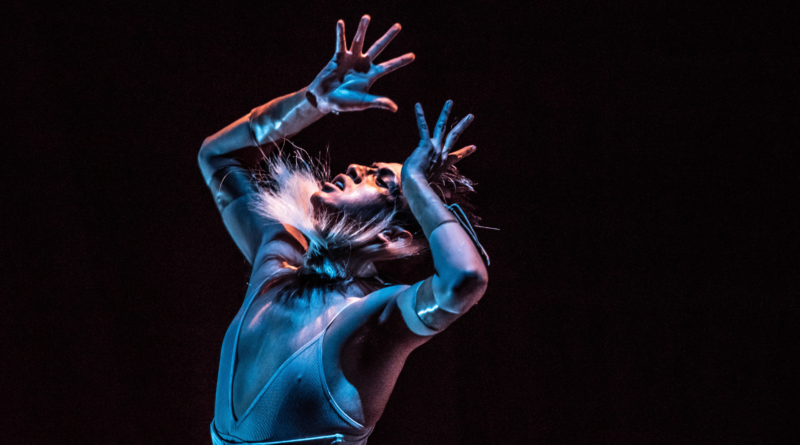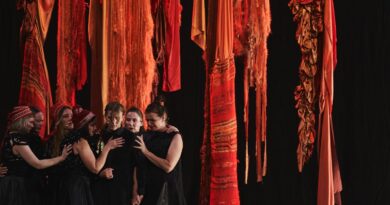Waawaate Fobister’s Omaagomaan is a powerful comment on the resilience of Grassy Narrows
Omaagomaan is an urgent and compelling narrative performance playing at Native Earth Performing Arts’ Aki Studio until February 18, 2024. Choreographed and performed by Dora-Award winning multidisciplinary artist Waawaate Fobister – and originally directed by the late Troy Emery Twigg – Omaagomaan unfolds through a dynamic combination of movement, sound, vocalization and storytelling that illuminate the story of the landscapes and community of Grassy Narrows.

Between 1962 and 1970, a chemical plant located southeast of Grassy Narrows, Ontario dumped several tonnes of mercury into the Wabigoon River. As a consequence, approximately 90% of the residents in the First Nation developed mercury poisoning from eating their now-contaminated main food source: fish from the river. In 2020, after years of litigation and inaction, the federal government reached an agreement to build a mercury poisoning care home in Grassy Narrows.
Omaagomaan depicts the valiant efforts of Grassy Narrows’ land defenders against the backdrop of persistent logging activities and the enduring mercury contamination, and highlights the community’s endeavors to heal the land. In a post-show talk back, Fobister explained that “Omaagomaan” means “layers” – in this case, the layers that make up the earth’s crust, and through which the man-made poisons seep.
Accompanied by a propulsive, pulsating soundscape by Marc Merilainen, Fobister is riveting as Omaagomaan, a two-spirit being and manifestation of the earth who is deeply rooted in Anishinaabeg cultural beliefs and cosmology. Omaagomaan emerges as a potent symbol of transformation and confrontation, compelling the audience to reflect on the juxtaposition of maanaadizi (ugly) and the onishishin (beautiful), and the intricate relationship between nature and human interference.
Whether dancing, clowning or interacting with the audience, the magnetic Fobister commands the stage and draws the audience’s gaze. Their acting skills infuse an agile, movement-based embodiment of diverse creatures and beings. And Pierre Lavoie’s lighting design is marvelous. When the show first opens, Fobister’s movements cast shadows like puppets on the curtains, visualizing the idea of layers and creating a wondrous link to the real and mythical.
Fobister grew up in Grassy Narrows First Nation before moving to Toronto and has seen the effects of mercury poisoning first-hand. They first conceived the idea for Omaagomaan at a pow wow and developed the show from an initial 5-minute version into a 20-minute piece at Native Earth’s 2-Spirit Cabaret. At this point, they invited Twigg to collaborate with them.
The performance is challenging and spellbinding. And I was moved by the audience reaction to Fobister and their show at the talk back following the performance on February 16. First of all, most of the capacity crowd audience chose to remain. And they were so curious to learn more about Fobister’s process and the individual elements of Omaagomaan that the scheduled 15-minute duration had to be extended. Many had travelled from afar to attend the performance, and several expressed their deep appreciation of the anishinaabe dialogue Fobister included in the show, and how it made them feel seen, heard and proud: close to their heritage, culture and family.

Prior to the current run at Native Earth Performing Arts, Fobister performed Omaagomaan in Munich, Germany and Peterborough, Ontario. They mentioned in passing that they continue to work on Omaagomaan – and that as a result, each performance is unique. The show’s state of perpetual evolution makes it even more worthy of a second (or third) look.
While two shows remain at Native Earth’s Aki Studio, the house is almost at capacity for both performances. If you want to see it – and you should – try to grab tickets right away on nativeearth.ca. And if you’re not lucky enough to see it (or see it again) during the current run, keep an eye out for when Fobister performs it – in its by-then new form – again.
© Arpita Ghosal, Sesayarts Magazine, 2024
About The Author
Arpita Ghosal
Arpita Ghosal is a Toronto-based arts writer. She founded Sesaya in 2004 and SesayArts Magazine in 2012.
Visit About Us > Meet the Team to read Arpita’s full bio …




